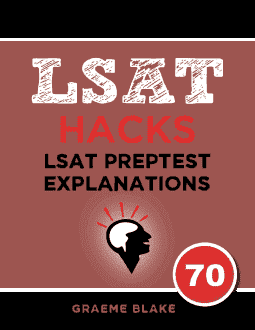QUESTION TEXT: Humorous television advertisements are the only effective…
QUESTION TYPE: Flawed Reasoning
CONCLUSION: Only funny ads work well.
REASONING: Funny ads hold people’s attention. Ads only work if they hold your attention.
ANALYSIS: Funny ads are sufficient to hold your attention. But other ads could also hold your attention – the stimulus didn’t show that funniness is necessary.
You can diagram this if you’d like. There are two conditional statements that don’t link up:
Funny ➞ holds attention
Effective ➞ holds attention
___________
- CORRECT. Maybe emotional ads can also hold people’s attention. Then funny ads wouldn’t be the only kind that could be effective.
- The argument doesn’t do this. The second sentence says that funny ads attract and hold your attention.
- I found this very tempting. The argument implies that funny ads are effective, when all we know is that funny ads meet a necessary condition for effectiveness.So why isn’t this right? It’s because the main point of the conclusion is that funny ads are the only effective ads i.e. that no other ads can be effective. So A is the best answer. Though there is a case to be made that this answer is also right and that the question is flawed.
- The stimulus uses “effective” the same way each time. To pick this type of answer, you have to say what the two different definitions of effective are.
- The stimulus didn’t even talk about the purpose of an advertisement. An answer can’t be the flaw if it didn’t happen.


hey Graeme,
I think C might actually be a valid wrong answer. the argument concludes that the only effective ones (ads) are funny ads, hence funny ads is a necessary condition in the conclusion. on the other hand, the premise says if something is funny it will attract attention and hold attention, so, funny ads is a sufficient condition in the premise. I think answer choice C has it backwards. had it said “it treats a sufficient condition for an ad’s being effective as if it were a necessary condition” then it would’ve been correct. Please let me know if I’m making a mistake. p.s. thank you so much for posting these helpful tips and analyses. they’ve been SO helpful.
You’re right that “funny” is sufficient in the premise. But it’s sufficient for holding attention, not sufficient for an ad being effective.
So since the argument never gives a sufficient condition for effectiveness, C can’t be right. Make sense?
Glad you like the explanations!
Wait I’m a confused. The final sentence of the stimulus says “and obviously, for an advertisement to be effective it MUST convey its message”.
Okay so that is a necessary condition statement, right? Necessary conditions don’t on their own allow you to draw a conclusion, but the stimulus does anyway. Answer C is that it takes a necessary condition, but incorrectly USES it as if it were a sufficient condition.
Doesn’t it do exactly this? The reasoning in the argument is that humorous television ads keep people’s attention, which means they successfully convey their message. So if we were to treat a necessary condition like how conveying message successfully is a must for effectiveness, but instead treat it as if it were a sufficient condition, then yes with that previously-necessary-condition-but-now-repurposed-erroneously-as-a-sufficient-condition, the stimulus tries fallaciously to conclude what it does.
———
Mapped out it is thus:
To be effective, you definitely need to convey your message.
Humorous ads convey their message.
Thus, humorous ads are going to be effective.
That is fallacious. If instead though we treat that first necessary condition instead like a sufficient condition, it would go:
To be effective, conveying your message successfully is plenty sufficient, no more is needed past that.
Humorous ads convey their message successfully.
Thus, humorous ads will be effective.
I think it’s easier if you diagram it like this:
If Effective –> Humorous
If Humorous –> Attract Attention and Convey Message (we’re only interested in this second part)
Thus: If E –> H –> AA and CM
This logic chain looks pretty good right? That means there isn’t a flaw in the necessary/sufficient part of the argument. It’s something else. Answer Choice C is irrelevant. Usually when this sort of answer choice comes up, you can expect the N/S logic chains to be messed up. In this case, Answer Choice A is better since what if there’s something else that can also guarantee (have as a necessary condition) AA and CM? Then Humor wouldn’t “the only effective ones”. That is the flaw here, which is assuming that only Humor can bring about Effectiveness. For example, what about emotional ads? Those can also attract attention and convey a message! They would surely also be effective.
I don’t think that this formal logic actually can be linked up. You linked up “If Humorous –> … and Convey Message,” but the stimulus text says “hold attention long enough for message to be conveyed.” That is different than saying a message was actually conveyed. Just because something has the opportunity to be conveyed (holds attention for long enough) doesn’t mean that a message was conveyed. What if the ad held my attention for long enough with crazy fantastic edits but didn’t actually say anything? I diagrammed it as:
Effective–> funny
_________________
funny–>attract attention + hold attention
Effective–> convey message
Lmk if I’ve made any mistakes here, thanks!
I think “holds attention long enough for the message to be conveyed” necessarily implies that the message WAS successfully conveyed.
In your example, the ad with crazy fantastic edits certainly held your attention but did not “hold your attention long enough for a message to be conveyed”. It’s possible that the ad itself could never have really conveyed its message to you – the time necessary in this case is longer than the ad could reasonably be.
I hope this clears it up a bit!